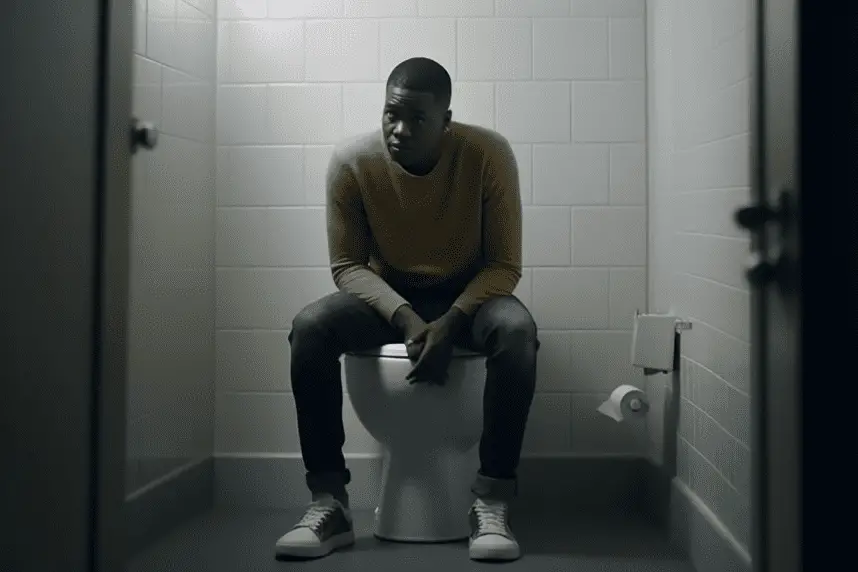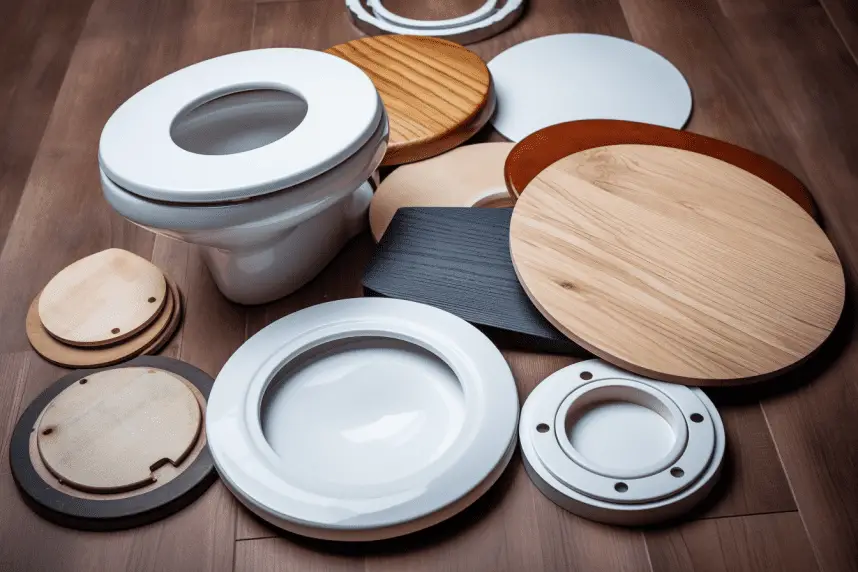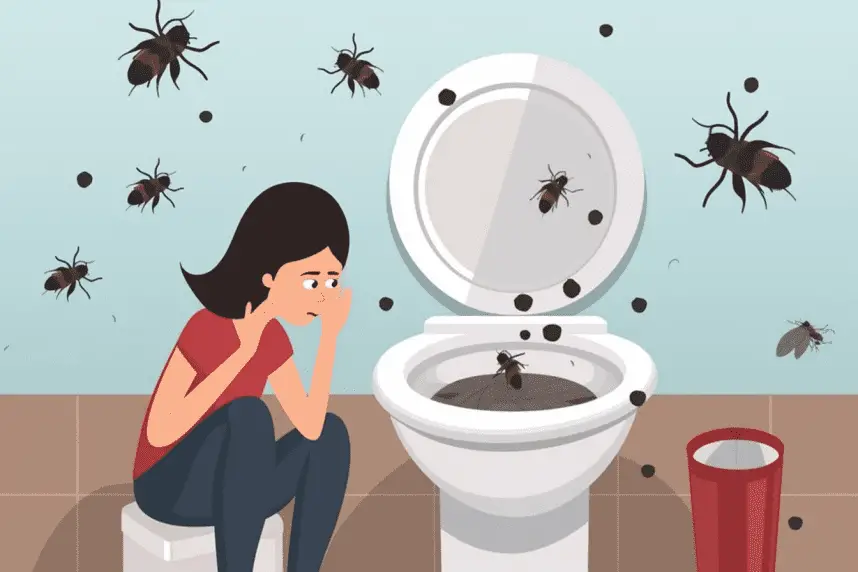Sitting on toilet lids is common in public restrooms, but is it safe and hygienic? While some believe it’s the perfect way to take a break after a long day, others think it’s unsanitary and could lead to serious health risks. This article will explore the pros and cons of sitting on toilet lids and offer some practical tips for those who choose to do so.
In this article, we’ll examine why people might sit on toilet lids, whether any safety issues need to be considered, and what steps can be taken to ensure good hygiene.
We’ll also discuss the opinions of different health experts regarding the practice. By the end of this piece, readers should better understand how they can safely use toilet lids if they choose to do so.

Materials Used To Make Toilet Lids
The materials used for making toilet lids varies depending on the style and the price of the toilets. Many prefer to have a stylish toilet which uses a stylish wood or some materials for the toilet lids. Here are some of the common and most used materials used to make toilet lids:
Porcelain
Porcelain is a popular material used to make toilet lids due to its aesthetic appeal and affordability. It’s relatively easy to install, and it’s also great for sanitization purposes – wiping down with a cloth or even a disinfectant can keep it clean.
Cost-benefit analysis reveals that porcelain is usually the most cost-effective choice for a toilet lid since it’s not as expensive as other materials and still offers good durability. However, it’s important to check that the porcelain lid is installed correctly, as gaps between the lid and the toilet bowl can be breeding grounds for bacteria. All in all, porcelain lids are an excellent option for those looking for an affordable yet durable addition to their bathroom.
Plastic
Plastic is another popular material used to make toilet lids. Porcelain is more common than porcelain, but it offers excellent durability and is usually quite affordable. Plastic lids can be tested for their longevity and may require certain cleaning techniques to keep the surface hygienic.
When comparing prices between plastic and porcelain, plastic often comes out cheaper – but it might not last as long. Plastic balances cost and durability, making it a viable option for those looking to save money while maintaining a sterile bathroom environment.

Wood
Wood is a great material for toilet lids, but it’s less common than plastic or porcelain. It’s important to consider the wood selection when choosing a wood lid for your toilet, and it might require more maintenance than other materials. Wood can easily be stained and finished with different coatings to suit your needs, but it may need to be refinished over time.
Wood lids can add a unique touch to any bathroom and are usually quite affordable too! All in all, wood is an excellent choice for those looking for a sturdy yet stylish option.
Assessing The Safety Of A Toilet Lid
When it comes to toilet lids, the materials used in their construction are just as important as their design. Different materials have different levels of durability and can affect the lifespan of a toilet lid. Installing the correct lid type is crucial for ensuring it meets safety standards and lasts many years.
Plastic is the most common material used for toilet lids, usually polypropylene or polyethylene. Plastic is lightweight and relatively inexpensive, making it an ideal choice for many households. Plastic lids need to be checked periodically to ensure they are securely fastened and in good condition; they may need to be re-installed if they become loose or start to crack.
When evaluating toilet lid designs, there are a few key factors: weight capacity, dimensions, construction material, color, and shape. When installing a new lid, it’s essential to make sure all instructions are followed carefully and that any hardware supplied with the lid is installed properly. These steps will ensure that your lid is safe and durable for years.
Potential Health Concerns Associated With Sitting On Toilet Lids
Sitting on a toilet lid may seem like an innocuous activity, but serious health risks are associated with it. While it may provide some brief comfort, the potential consequences of engaging in this behavior could be far-reaching. Understanding the hygienic precautions, lid strength, and surface temperature associated with sitting on toilet lids is essential for ensuring optimal safety.

One of the primary concerns related to sitting on a toilet lid is the potential for infection due to bacteria and germs in the area. Taking hygienic precautions such as washing hands before and after using the restroom helps to reduce these risks. Additionally, individuals should be aware of how much weight the toilet lid can safely bear before breaking or collapsing under their weight.
Toilet lids without any visible damage or structural defects can still be fragile if they are not designed to support the extra weight. Finally, individuals should also be aware that certain surfaces can become very hot when exposed to direct sunlight or heat sources, creating a risk of burns if someone were to sit on them without protection.
Given all these potential health risks, it is best to avoid sitting on a toilet lid altogether. Taking hygienic precautions and being aware of lid strength and surface temperature can help ensure that people stay safe while using bathroom facilities.
Tips To Make Sitting On Toilet Lids Safer
First, it’s important to check the weight of the toilet lid before sitting on it; if it’s too heavy, it might be unsafe. Second, it’s a good idea to use a non-slip mat on the lid to prevent slipping and sliding while sitting.
Third, it’s best to use a toilet lid designed specifically for sitting, as these are more likely to be sturdier and more secure. Finally, it’s a good idea to check the toilet seat periodically for any signs of wear and tear.
Check Weight
It’s not always easy to find a comfortable spot to relax, and sometimes you might even be tempted to sit on a toilet lid. But before you do, it’s important to consider the safety risks of such an action. Before sitting on the toilet lid, be sure to check the seat’s weight capacity and strength.
Make sure it can handle your weight, or you risk damaging the lid and injuring yourself due to lack of stability. Remember that a toilet lid isn’t designed for sitting and can become dangerous if not used properly, so use caution if considering this option. To avoid any potentially hazardous situations, consider other seating options instead of relying on toilet lids.
Use Non-Slip Mats
If you insist on sitting on a toilet lid, there are some extra precautions you can take to make it safer. For example, you can use anti-slip coatings or mats to fit the size of your toilet lid. This will help reduce slipping and improve stability.
Also, heck the lid size to ensure it does not exceed your weight capacity. Finally, clean the area before and after using it with an appropriate cleaning method. This will help keep the area hygienic and prevent any potential health risks associated with sitting on a toilet lid.
Alternatives To Sitting On Toilet Lids
Sitting on a toilet lid is often an uncomfortable and potentially dangerous activity. Luckily, plenty of seating alternatives help make your bathroom experience more enjoyable and safe. The installation process for these alternatives is usually quite simple and can be done easily with the right tools.
For example, bath seats are designed to fit onto your existing toilet bowl and provide extra stability while using the bathroom. They can also come with adjustable heights to suit different body shapes, making them an ideal choice for people of all ages.
When considering alternative seating options, it’s important to consider the product’s durability. Toilet lids are typically made from plastic or ceramic materials, which can wear down over time, leaving you vulnerable to falls or other injuries. Alternatives like bath seats are typically made from stronger materials like stainless steel or aluminum, which will last much longer than traditional lids. Additionally, many of these products come with warranties that guarantee their durability for up to a few years.
No matter what type of seating you choose for your bathroom, it’s important to make sure it provides adequate support and stability during use. Investing in a high-quality product will ensure that you don’t have to worry about replacing it anytime soon and that you’ll be able to enjoy a comfortable and safe experience every time you use the bathroom.
Frequently Asked Questions
Are There Any Weight Restrictions For Sitting On A Toilet Lid?
When it comes to sitting on toilet lids, there are indeed weight restrictions to consider for a safe installation. Depending on the design of the lid, some can only support up to 250 pounds of weight or less before becoming damaged.
Therefore, it is important to take into consideration both the proper hygiene practices as well as the strength of the lid before attempting to sit on one. Furthermore, it is best to look into lid designs specifically designed with increased stability and safety in mind.
Do Different Types Of Toilet Lid Materials Have Different Levels Of Comfort?
When considering the comfort of a toilet lid, it is important to consider proper installation, materials comparison, and safety standards. Different types of materials used for toilet lids can have varying levels of comfort.
The most commonly available materials are plastic, plastic composites, and stainless steel. Plastic will generally be the least comfortable, while stainless steel may be the most comfortable due to its strength and durability. However, it is important to keep in mind that all toilet lids must meet certain safety standards as set by local building codes.
Can Sitting On A Toilet Lid Damage The Toilet Or The Lid?
When it comes to sitting on a toilet lid, damage to both the toilet and the lid can be a risk. Toilets are designed to be watertight, and when someone sits on the lid, this can compromise the seal and cause water leakage.
Depending on the design of the lid, its structure may not be able to bear substantial weight. Air circulation is also important for some toilets, which could be hindered if someone were to sit on the lid. Therefore, considering these factors, it is best to avoid sitting on toilet lids.
Are There Any Age Restrictions For Sitting On A Toilet Lid?
When it comes to sitting on a toilet lid, there are age restrictions that should be taken into consideration. Proper posture, lid size, and weight distribution all play a role in the safety of someone sitting on a toilet lid. The best practice is to have children under the age of 18 not sit on toilet lids as their size and weight may not be properly distributed over the lid, causing it to break or damage the toilet.
Adults should check to make sure their posture is correct so that their weight is evenly distributed. If the toilet lid does not feel secure and sturdy enough for them to comfortably sit on it, then they should avoid doing so.
Are There Any Long-Term Health Risks Associated With Sitting On Toilet Lids?
When it comes to the long-term health risks associated with sitting on toilet lids, there are a few things to consider. Firstly, cleaning habits can play a role in the safety of sitting on a toilet lid.
Secondly, water pressure and temperature differences must be taken into account when determining whether or not it is safe to sit on a toilet lid. Ultimately, if you have concerns about the safety of sitting on a toilet lid, you should consult your doctor for specific advice.
Conclusion
It’s important to consider the weight, material, and age restrictions before sitting on a toilet lid. You should also be aware of any potential long-term health risks associated with doing so.
So, it’s up to you to decide whether or not it’s safe for you to sit on a toilet lid. If you’re concerned about any of the above factors, then avoid doing so. Just remember that if you choose to sit on a toilet lid, make sure it’s strong enough and has the right material for your body weight and age.
